 The very first thing God told Muhammad or the first communication that happened to him was a verbal sign: "to read", "Eghraa!", not to write, read! What is the meaning of reading, and rereading, or which text God demanded to read? To just perform reading or just to go ahead and translate things, pushing translation to the limits. And this Eghraa becomes very crucial, because this reading like all acts of reading is pregnant of misunderstanding and deviance.
Years later my female neighbour puts her finger in her mouth while talking to a Na-Mahram man
Deep throat
Reader
Reciter of Kitab
Rawi (راوی) someone who reads, translates, and suspends the poetry of the performing poets, now can also mean a standpoint in a story
Forgetting / Memorizing
The very first thing God told Muhammad or the first communication that happened to him was a verbal sign: "to read", "Eghraa!", not to write, read! What is the meaning of reading, and rereading, or which text God demanded to read? To just perform reading or just to go ahead and translate things, pushing translation to the limits. And this Eghraa becomes very crucial, because this reading like all acts of reading is pregnant of misunderstanding and deviance.
Years later my female neighbour puts her finger in her mouth while talking to a Na-Mahram man
Deep throat
Reader
Reciter of Kitab
Rawi (راوی) someone who reads, translates, and suspends the poetry of the performing poets, now can also mean a standpoint in a story
Forgetting / Memorizing Remembering To talk from the memory and not from a researched knowing Am I another reciter? The importance of the "word" in Islam. Quran is not read, it is taught verbally, teaching upon teaching (and the voice who reads it) Teaching is synthesizing for someone else Rumi as an example of revisiting the poet/reciter relationship. performative speech-act of his orations and well crafted written poetry that made him later famous. Perverse ears Eyes / Ears Travel of the eye Gene in history rape Ambassadorial activity of performance, bringing of a story from another time or place to the eyes and ears of the spectators Sending of ambassadors to foreign lands to spread the Islamic call, a moment of scandalous colloquial encounter, combination of embarrassment and excitement of the exchanged gazes, between metaphoric threat to enslavement and warm presentation of an idea, translation and interpretation. The word of Allaah is nicely presented ending always with a "but if you refuse...". Mad preacher, monks were sent to pagan countries, a monk that has forgotten his education but still gives sermons to a public that is interested in his madness, he is curious of what he might say. Revisiting sermon—the discourse inherent in the relation with the other is like or as a sermon? Roll of the voice in the history of Islam Convincing the leaders of Yathrib not to kill them, just by singing two verses. The city is now known as Medina which was personally named by Muhammad. Muhammad's victories by his singing ...from the scene of performing poetry at the pagan bazaar at the international slave market and the place of trade and exchange around Kaaba shrine in Medina, the relation to the “text” will transform to the be the “reciter”, someone that now recites Muhammad’s voice, with a touch of his own translation. This touch is of high importance later in the history, this is precisely what that will later escalate into the body of Islamic state. Recitation should be done according to rules of pronunciation, intonation, and caesuras established by evolution of Arabic language in the scene of poetry, oration, and singing. Recitation should be done according to rules of pronunciation, intonation, and caesuras established by the Islamic prophet Muhammad, though first recorded in the eighth century CE.
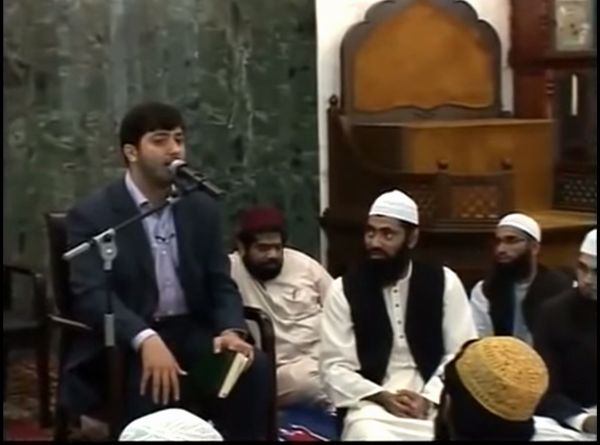 Recitation of Quran by Jawad Faroughi in Hong Kong 2007.
The primitive Arabic diacritics, containing short and long vowels and sonorous letters, are contributed with a kind of affective accentuation in Quran chanting and also in vocal performance in general. The human voice as device of communication, weather expressing basic instinctive demands through sounds of a primitive nature, or by more sophisticated, intellectual means including language and singing, the absolute superiority of the voice as producer of meaningful sounds and carrier of messages, weather associated with words or not, is shared by many thinkers from the early and middle Islamic era.
Recitation of Quran by Jawad Faroughi in Hong Kong 2007.
The primitive Arabic diacritics, containing short and long vowels and sonorous letters, are contributed with a kind of affective accentuation in Quran chanting and also in vocal performance in general. The human voice as device of communication, weather expressing basic instinctive demands through sounds of a primitive nature, or by more sophisticated, intellectual means including language and singing, the absolute superiority of the voice as producer of meaningful sounds and carrier of messages, weather associated with words or not, is shared by many thinkers from the early and middle Islamic era.
 project by Sina Seifee presented at KHM 2014 promoted by openlab. performance lecture in English with occasional singing verses of Quran in Arabic, as someone who has grown up in Iran during the development of country’s educational and religious doctrinaire after the revolution, the body of the performer is tattooed by its teaching, the performance loosely borrows the formal aspects of a short Khutbah and takes on a history of the origins and habits of Islam.
project by Sina Seifee presented at KHM 2014 promoted by openlab. performance lecture in English with occasional singing verses of Quran in Arabic, as someone who has grown up in Iran during the development of country’s educational and religious doctrinaire after the revolution, the body of the performer is tattooed by its teaching, the performance loosely borrows the formal aspects of a short Khutbah and takes on a history of the origins and habits of Islam.
 Lecture in English project by Sina Seifee at Biozentrum Köln Insect Lab2 2014 promoted by Kunsthochschule für Medien Köln. The Lecture aims at the relationship between the different voices in Islam. Islam and European enlightenment do not go together. However Islam is present at today’s science laboratory where their roots meet at the 12th century, when classic texts were being translated back from Arabic to Latin, an event that introduced science back to the Latin West in the Middle Ages.
Lecture in English project by Sina Seifee at Biozentrum Köln Insect Lab2 2014 promoted by Kunsthochschule für Medien Köln. The Lecture aims at the relationship between the different voices in Islam. Islam and European enlightenment do not go together. However Islam is present at today’s science laboratory where their roots meet at the 12th century, when classic texts were being translated back from Arabic to Latin, an event that introduced science back to the Latin West in the Middle Ages.
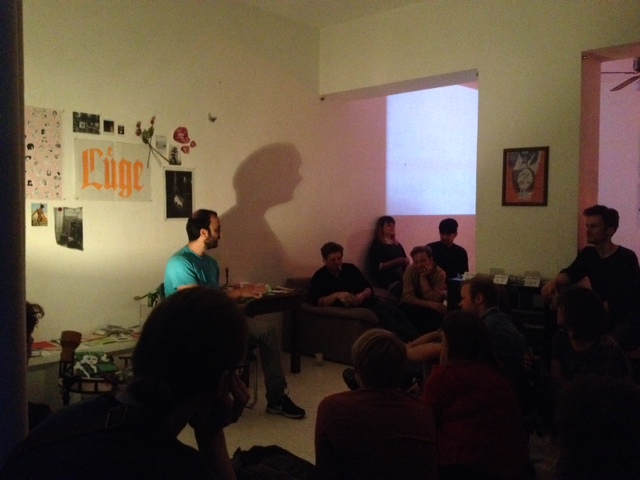 Undesirable Decidability -the Indecisions of Sanctity in Early Islam, performance at release-event of Shilly Shally #2 at SCHALTEN UND WALTEN, köln 2014. By looking closely at one of the saints of Islam, Alī ibn Abī Ṭālib, the relations between spontaneity and undecidability are presented in the historical body of a soldier of Islam. Narrations laid out in the speech-act are: the spontaneity of big bang, Derridean undecidables, pure paralyzation of the play of signifiers for Alī when he looks at the oscillation between possibilities that are determined in a defined situation, and the necessity of spontaneity for community also its dangers for criminal grouping.
Undesirable Decidability -the Indecisions of Sanctity in Early Islam, performance at release-event of Shilly Shally #2 at SCHALTEN UND WALTEN, köln 2014. By looking closely at one of the saints of Islam, Alī ibn Abī Ṭālib, the relations between spontaneity and undecidability are presented in the historical body of a soldier of Islam. Narrations laid out in the speech-act are: the spontaneity of big bang, Derridean undecidables, pure paralyzation of the play of signifiers for Alī when he looks at the oscillation between possibilities that are determined in a defined situation, and the necessity of spontaneity for community also its dangers for criminal grouping.
 Courses, sermons, lectures of l’imam Rachid abou Houdeyfa found on his Website, performing rapid annunciation and heavy mixture of Arabic and French.
Courses, sermons, lectures of l’imam Rachid abou Houdeyfa found on his Website, performing rapid annunciation and heavy mixture of Arabic and French.
 “If you doubt the truth of something, then that thing is probably wrong“ Hossein Elahi Ghomshei, an Iranian domestic lecturer on literature art mysticism, animates flawlessly vivid imageries with poetry and heavy use of story-telling and mobilizes his audience in semi-mystic rhetoric in a specialized Farsi and Arabic textual world. He is famous for his fluency of allusive narration and a vast knowledge of literature that he can recall and connect effortlessly to the topic at hand.
Muhammad
Sayyid, an honorific title denotes males accepted as descendants of the Islamic prophet Muhammad through his grandsons, being a Sayyid gives the owner an unofficial license to perform Khutbah
Prophet waking up from a hallucination or revelation with a hard-on, instead of a mission. The morning hard-on, man's most magnificently manifestation of masculinity, has the same turbulent thrusting force and energy of a rocket ready to be launched.
Still travelling in his dreams, to Jerusalem
Muhammad and his desires
Imagine Muhammad as a young man, good-looking handsome man, with beautiful voice, would sit in his public or in an alley and perform his poetry and people listened to him.
institutionalized reciting of Muhammad's poetry
Conversing with Caravan trades
He formalized an ideology on two terms: first uniting Arabs and second cleaning them up—skin and tongue
Transforming Arabia from slave-owning society to feudalism required formation of class and decay of patriarchal way of life which really happened way later after the conquests
Kaaba, not so shy, is a black cube in the middle of land, an architecture that appears in the horizon, not that which reveals itself like an interior of mosque
Kaaba was itself a female deity and the circumambulation was performed by naked male pilgrims, a pagan shrine within it orgy of Mediterranean gods. Kaaba used to host polytheism and multiplicity of identities while offering a combat free zone perfect for trading
Masjid al-Haram is another example of a pagan shrine translated into a monotheist centroid, another name of Kaaba when overtaken by Muhammad and sealed its door
“If you doubt the truth of something, then that thing is probably wrong“ Hossein Elahi Ghomshei, an Iranian domestic lecturer on literature art mysticism, animates flawlessly vivid imageries with poetry and heavy use of story-telling and mobilizes his audience in semi-mystic rhetoric in a specialized Farsi and Arabic textual world. He is famous for his fluency of allusive narration and a vast knowledge of literature that he can recall and connect effortlessly to the topic at hand.
Muhammad
Sayyid, an honorific title denotes males accepted as descendants of the Islamic prophet Muhammad through his grandsons, being a Sayyid gives the owner an unofficial license to perform Khutbah
Prophet waking up from a hallucination or revelation with a hard-on, instead of a mission. The morning hard-on, man's most magnificently manifestation of masculinity, has the same turbulent thrusting force and energy of a rocket ready to be launched.
Still travelling in his dreams, to Jerusalem
Muhammad and his desires
Imagine Muhammad as a young man, good-looking handsome man, with beautiful voice, would sit in his public or in an alley and perform his poetry and people listened to him.
institutionalized reciting of Muhammad's poetry
Conversing with Caravan trades
He formalized an ideology on two terms: first uniting Arabs and second cleaning them up—skin and tongue
Transforming Arabia from slave-owning society to feudalism required formation of class and decay of patriarchal way of life which really happened way later after the conquests
Kaaba, not so shy, is a black cube in the middle of land, an architecture that appears in the horizon, not that which reveals itself like an interior of mosque
Kaaba was itself a female deity and the circumambulation was performed by naked male pilgrims, a pagan shrine within it orgy of Mediterranean gods. Kaaba used to host polytheism and multiplicity of identities while offering a combat free zone perfect for trading
Masjid al-Haram is another example of a pagan shrine translated into a monotheist centroid, another name of Kaaba when overtaken by Muhammad and sealed its door
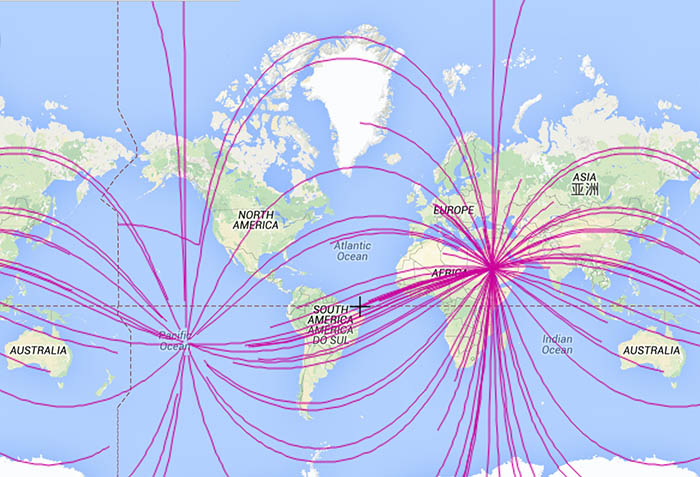 Qiblah is the direction that should be faced when a Muslim prays during Salat. It is fixed as the direction of the Kaaba in Mecca. In April 2006, Malaysian National Space Agency sponsored a conference of scientists and religious scholars to address the issue of how the Qiblah should be determined when one is in orbit. The determination of the direction of the Qiblah is now necessarily the convergence of unholy disciplines. The diagram shows the shortest distance between any point on the retroazimuthal map projection centred on Mecca, the projection produces a pseudo spatial horizon somewhere in the middle of Pacific Ocean, a location that directionality is lost for the unity of prayer, this point is accidentally on the Atoll of Mururoa a nuclear weapon testing site for France undertook between 1966 and 1996.
pray
Qiblah is the direction that should be faced when a Muslim prays during Salat. It is fixed as the direction of the Kaaba in Mecca. In April 2006, Malaysian National Space Agency sponsored a conference of scientists and religious scholars to address the issue of how the Qiblah should be determined when one is in orbit. The determination of the direction of the Qiblah is now necessarily the convergence of unholy disciplines. The diagram shows the shortest distance between any point on the retroazimuthal map projection centred on Mecca, the projection produces a pseudo spatial horizon somewhere in the middle of Pacific Ocean, a location that directionality is lost for the unity of prayer, this point is accidentally on the Atoll of Mururoa a nuclear weapon testing site for France undertook between 1966 and 1996.
pray
 Kaaba in the courtyard of the Great Mosque in Mecca is covered by a black robe, called Kiswah (robe) that has Quranic verses embroidered with gold thread on it. Each year a new one is created and, prior to 1927, it was provided by Egyptian artisans who brought it with them in a pilgrimage caravan that travelled from Cairo. Kaaba sets the geographical rotational axis for the body of the Muslims around the world, wherever they are they face this point during the prayer.
Kaaba in the courtyard of the Great Mosque in Mecca is covered by a black robe, called Kiswah (robe) that has Quranic verses embroidered with gold thread on it. Each year a new one is created and, prior to 1927, it was provided by Egyptian artisans who brought it with them in a pilgrimage caravan that travelled from Cairo. Kaaba sets the geographical rotational axis for the body of the Muslims around the world, wherever they are they face this point during the prayer.
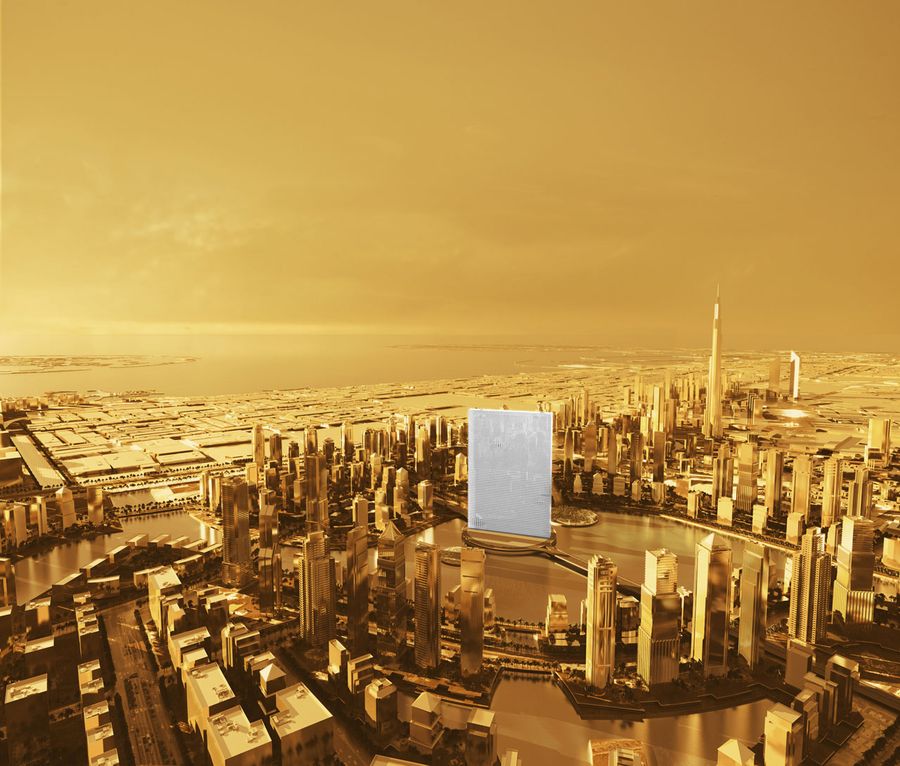 Dubai Renaissance
Dubai Renaissance A rotating building, project proposal by OMA (Office for Metropolitan Architecture), is “a single monolithic volume constructed, like an elevator core, in one continuous operation – 200 meters wide and 300 meters tall comprising of offices and business forums, hotel and residential suites, retail, art and urban spaces.
The ambition of this project is to end the current phase of architectural idolatry –the age of the icon– where obsession with individual genius far exceeds commitment to the collective effort that is needed to construct the city...”
OMA suggests by using the box as the most functional form for program and construction its design is a subversive statement against the status quo of icon building and that architecture must build the community.
What Le Corbusier would have thought of that?
(Image courtesy of the Office for Metropolitan Architecture) The voice that despatches Meeting with the old voice The unknown girl’s voice—a beautiful bisexual nymphomaniac Fingers Reciter turning into institution—Sharia The ancient Arabia before Muhammad Poetry, in the festival There were festivals, where poets would come around and would improvise against one another. It was a place for exchange of language, slaves, and material. The language was precisely made here. The language of Quran was not made in the divine lab or the scientific lab; it was forged by the drunken, high on hashish Arab, on the move, on the immediacy of performing poetry. This language will make us high on its substance later at recitation. Drunken high on hashish poetry in action Zajal a traditional form of oral strophic poetry declaimed in a colloquial dialect (most notably in one of the many dialects of Arabic) with ancient roots in Pre Islamic Arabia.
 Heated session of Lebanese Zajal is semi-improvised and semi-sung, a traditional form of oral strophic poetry declaimed in a colloquial dialect with ancient roots in Pre Islamic Arabia. The performers rival in sophistication and metric variety in front of their enthusiastic aficionados. The co-existence of formal and colloquial forms of the Arabic tongue in Lebanon is the condition for Zajal to address the multi-ethnic and multi-sectarian Lebanese Zajal, its infusion of vocabulary from colonial languages make it a threat to pan-Arabism.
Heated session of Lebanese Zajal is semi-improvised and semi-sung, a traditional form of oral strophic poetry declaimed in a colloquial dialect with ancient roots in Pre Islamic Arabia. The performers rival in sophistication and metric variety in front of their enthusiastic aficionados. The co-existence of formal and colloquial forms of the Arabic tongue in Lebanon is the condition for Zajal to address the multi-ethnic and multi-sectarian Lebanese Zajal, its infusion of vocabulary from colonial languages make it a threat to pan-Arabism.
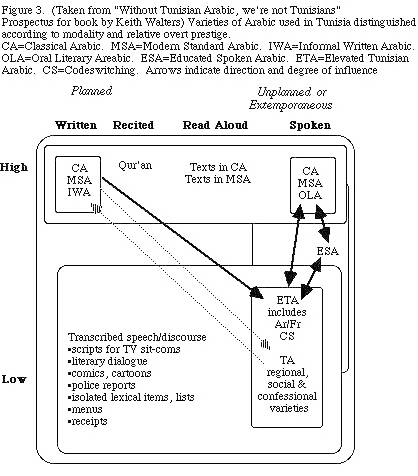 Most of the today Arabic-speaking nations were conquered by Arabs in the Middle Ages once had their own native tongue. Diglossia can describe the linguistic situation in many of these Arabic-speaking countries, the widespread existence within a society of sharply divergent formal and informal varieties of a language each used in different social contexts or for performing different functions, as the existence of Katharevusa and Demotic in modern Greece. Rarely achieving a total uniformity, these societies are almost always mixed-language communities.
Most of the today Arabic-speaking nations were conquered by Arabs in the Middle Ages once had their own native tongue. Diglossia can describe the linguistic situation in many of these Arabic-speaking countries, the widespread existence within a society of sharply divergent formal and informal varieties of a language each used in different social contexts or for performing different functions, as the existence of Katharevusa and Demotic in modern Greece. Rarely achieving a total uniformity, these societies are almost always mixed-language communities. (Diagram, work of the linguistics professor Keith Walters at the University of Texas at Austin on Tunisian Arabic, shows the varieties of Arabic used in Tunesia distinguished according to modality and relative overt prestige.) performance poetry Hygiene, maintaining health There are specific and strict rules how to clean yourself in Islam, emphasized repeatedly and embedded in the ritual of praying, Namaz or Salat. Now one takes a shower, and I am thinking taking a shower, where does it come from, and how do I learn how to take a shower. From my parents when I was a child? And where did they learned it? But it blew me away when I showered with a stranger, and I realized that how profound was it when my body went through a different history suddenly with water, and the temperature, and the closeness of another body. So taking a shower with someone whose body differed rocked my religion. I would suggest just as a religious experiment, try it out if you dare and you desire. Wine, Kitab (Quran) is all wet in it Body is externally oriented by Kaaba and internally by the Kitab Unity, patriarchal society Self in Arabia
 The public official of religious representative in Islam talks in the sacred space, the hyper-mosque. This is a mental space more than an architectural space. To perform the religious text in a place reserved for science or artistic tests, is an experiment with the sacred space that lacks the ritualistic and symbolic actors which construct it. The symbolic necessity and cultural significant of the mosque where the Khutbah happens, is of undoubted importance, however there have been no relationship between the artists and that which goes on within the mosque –there have been no dialogue between creativity and the demands of worship. Wherever there are cultural traces there are religious ones too.
In the pre-Islamic Arabia, the voice was considered to have the ability to generate magical sounds by means of intonation patterns in the performance of a song, and even in the ordinary recitation of a poem. Many considered the voice in speech and song as a reflection of various passions, and as a vehicle of communication. For the mystics, it symbolized the divine life and brought man into resonance with the celestial and universal. The voice is therefore the most perfect means of expression and communication. In its context in Arabia, the voice of the prophet was and is fully composed of spiritual substances, something that pierced the souls of the hearers. Before Muhammad started his preaching, his melodies which were composed of rhythms and words, were leaving an impression on the souls of his equals.
Dating back to the foundation of its roots Islam was partly shaped due to the necessity of uniting the societies in the peninsula of Arabia, therefore the high stakes of interrelationships can be traced in its DNA. Islam was made for community, it is neither a silent meditation nor an individual pilgrimage through time and space, and it does not invite for 'second though', therefore apt for action and reaction towards others either believers or non-believers.
Three reversal paths: First, the interrogatory aspect of the relationship within the brotherhood in the society. The proof and the meaning of being a member of the Muslim community is an act of projection of desire and demand for righteousness in the others. Therefore, the other Muslim becomes the subject of constant (covert and overt) investigation for behavioral and moral correctness.
The public official of religious representative in Islam talks in the sacred space, the hyper-mosque. This is a mental space more than an architectural space. To perform the religious text in a place reserved for science or artistic tests, is an experiment with the sacred space that lacks the ritualistic and symbolic actors which construct it. The symbolic necessity and cultural significant of the mosque where the Khutbah happens, is of undoubted importance, however there have been no relationship between the artists and that which goes on within the mosque –there have been no dialogue between creativity and the demands of worship. Wherever there are cultural traces there are religious ones too.
In the pre-Islamic Arabia, the voice was considered to have the ability to generate magical sounds by means of intonation patterns in the performance of a song, and even in the ordinary recitation of a poem. Many considered the voice in speech and song as a reflection of various passions, and as a vehicle of communication. For the mystics, it symbolized the divine life and brought man into resonance with the celestial and universal. The voice is therefore the most perfect means of expression and communication. In its context in Arabia, the voice of the prophet was and is fully composed of spiritual substances, something that pierced the souls of the hearers. Before Muhammad started his preaching, his melodies which were composed of rhythms and words, were leaving an impression on the souls of his equals.
Dating back to the foundation of its roots Islam was partly shaped due to the necessity of uniting the societies in the peninsula of Arabia, therefore the high stakes of interrelationships can be traced in its DNA. Islam was made for community, it is neither a silent meditation nor an individual pilgrimage through time and space, and it does not invite for 'second though', therefore apt for action and reaction towards others either believers or non-believers.
Three reversal paths: First, the interrogatory aspect of the relationship within the brotherhood in the society. The proof and the meaning of being a member of the Muslim community is an act of projection of desire and demand for righteousness in the others. Therefore, the other Muslim becomes the subject of constant (covert and overt) investigation for behavioral and moral correctness. Second, like all religions, Islam is a theorization of death, it proposes a grasp of death in terms of a project for life and afterlife, thus constructing a relation to the other that is based via death on antagonism or communion –the other becomes merely part of my death project.
Third, the doctrine of self-perception as the instrument of God: “nothing is greater than God”, “I am an instrument of his will”, “nothing is greater than my judgement”. death's prestige In a verse, when the end of time approaches and all being is annihilated by the sound of a divine trumpet, what only remains is the face of God. While all being is discredited to acquire a face –it is not by chance that even the face of the prophet is covered in white or golden veil in the history of illustrative representation in Islamic art. Other than having aesthetic consequences, this will have ethical emanations on the attitude of the believing. For that the face of God who makes the divine ethical demand upon me, no other being can call for such morality other than God.
From that to the face beaten-up as a scene of violence is a metaphor for the faceless that no longer elicits moral responses, the face that is always already beaten...
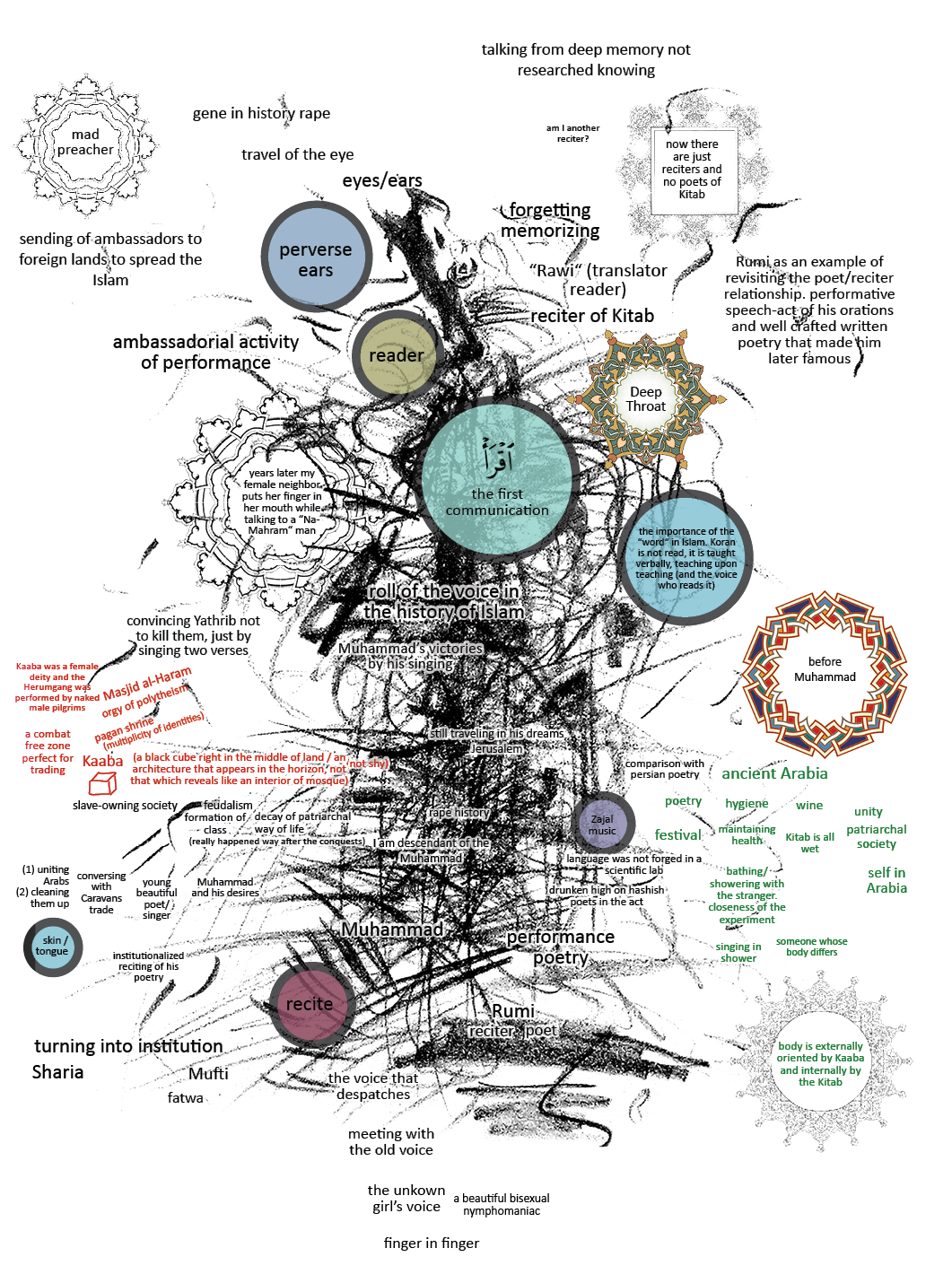 note on a performance, an into to Islam 2014, The performance-lecture draws a personal picture of the history of Islam, the story of voice, and digesting a life-experience of growing up in its realms. The lecture brings up the meaning of being a child in that certain society marked by the Islamic scholarship and ideology, and what that happens in the classroom structured by the ideas that were adapted from Islam and its traditions. The performance is an elaboration on the issue of memory, as something that is real but not actual. Memory is the space where art and love can be called into being, and perhaps –in a Deleuzian term– belongs to the virtual domain. The recalling of the past in the vortex of written or spoken propositions of Islamic textualities also entails its forgetting –a talking conciseness that tries to catch up to a contemporary image of science and art, but it fails to reach a therapeutic whole. There are themes of illustration and influence, issues of domain and selection which are raised by the juxtaposition of architecture, history, culture, and personal experience.
note on a performance, an into to Islam 2014, The performance-lecture draws a personal picture of the history of Islam, the story of voice, and digesting a life-experience of growing up in its realms. The lecture brings up the meaning of being a child in that certain society marked by the Islamic scholarship and ideology, and what that happens in the classroom structured by the ideas that were adapted from Islam and its traditions. The performance is an elaboration on the issue of memory, as something that is real but not actual. Memory is the space where art and love can be called into being, and perhaps –in a Deleuzian term– belongs to the virtual domain. The recalling of the past in the vortex of written or spoken propositions of Islamic textualities also entails its forgetting –a talking conciseness that tries to catch up to a contemporary image of science and art, but it fails to reach a therapeutic whole. There are themes of illustration and influence, issues of domain and selection which are raised by the juxtaposition of architecture, history, culture, and personal experience.
 A TSA agent waits for passengers to use the TSA PreCheck lane being implemented by the Transportation Security Administration at Miami International Airport on Oct. 4, 2011. Islam happens at the airport. Religious bodies are tested and provoked at the airport terminal on a daily basis. (photo: JOE RAEDLE/GETTY IMAGES)
A TSA agent waits for passengers to use the TSA PreCheck lane being implemented by the Transportation Security Administration at Miami International Airport on Oct. 4, 2011. Islam happens at the airport. Religious bodies are tested and provoked at the airport terminal on a daily basis. (photo: JOE RAEDLE/GETTY IMAGES)
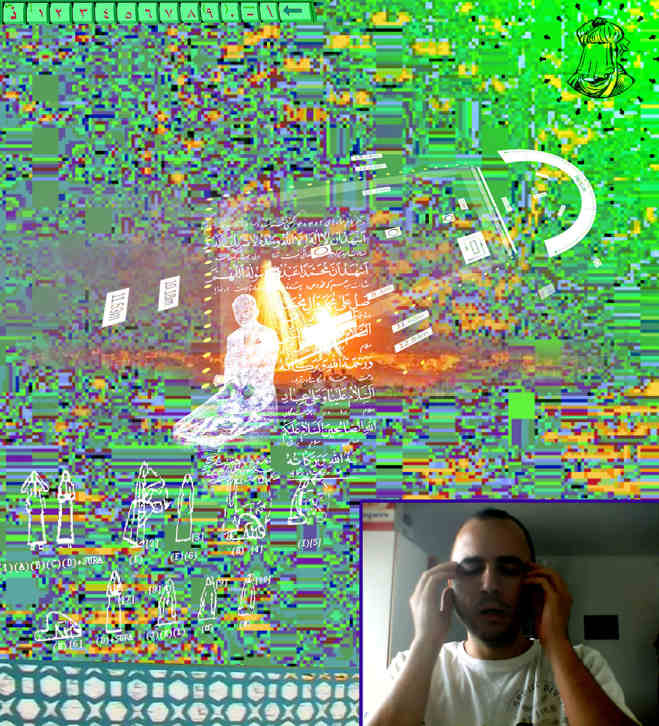 Performance Bodies of the Prophet and the Celestial Self sermoned and sang by Sina Seifee at King Georg club-bar, July 2015. Khutbah (short-lecture) on the fantasies of transformation in the body of prophet in Islamic teaching and the imagination of call with few recitations of Quran.
The lecture Bodies of the Prophet and the Celestial Self is performed in a bar in Cologne. The translation of thw word "bar" in Farsi matches the concept of میکده, which is a technical term in Tasavof (تصوف Iranian Sufism) for an important trope of the Sufi's layover.
Performance Bodies of the Prophet and the Celestial Self sermoned and sang by Sina Seifee at King Georg club-bar, July 2015. Khutbah (short-lecture) on the fantasies of transformation in the body of prophet in Islamic teaching and the imagination of call with few recitations of Quran.
The lecture Bodies of the Prophet and the Celestial Self is performed in a bar in Cologne. The translation of thw word "bar" in Farsi matches the concept of میکده, which is a technical term in Tasavof (تصوف Iranian Sufism) for an important trope of the Sufi's layover.
 the (Islamic) God has many names, almost endless as long as the language can withhold adjectives. Does he means to have no name? By that can he be at all identified or located in prayer? Unnameablity of the God deconstructs every attempt of pray to a specific target. He will not let himself to be addressed by the theist.
God's secret name, as proposed in the mystic tradition of Islam, remains an impossible stand for the believer. A word that he will never learn. The issue of the articulation of belief is opened my the many mystics that charged the religion by radically mystifying the God they had to believe in.
divine myth
The mysterious objectivity of the prophet's body in the architecture of value.
We may ask how and what the prophet is tuned to? Which anatomical departments is he invested in listening? In a comparative study of chronicles of Surahs of Quran one may arrive at an analysis of prophet's libido. By comparing the early Surahs from Mecca and the later ones from Medina we can spot a trace of change in Muhammad's psychobiology. The Surah's from Mecca indicate an authoritative generally angry Christian and Jewish God, and later in Medina this God develops a more Arabic voice and character who goes into obsessive details of practice.
During his marriage to Khadijah—Muhammad's first wife who was older than him—we can read in Quran's description of paradise the promise of Houris (Muslim paradise white-skinned black eyed girls), and later after her death when Muhammad had other younger wives, the Quran never mentions Houris again and the theist now enters the paradise with his earth wife.
the (Islamic) God has many names, almost endless as long as the language can withhold adjectives. Does he means to have no name? By that can he be at all identified or located in prayer? Unnameablity of the God deconstructs every attempt of pray to a specific target. He will not let himself to be addressed by the theist.
God's secret name, as proposed in the mystic tradition of Islam, remains an impossible stand for the believer. A word that he will never learn. The issue of the articulation of belief is opened my the many mystics that charged the religion by radically mystifying the God they had to believe in.
divine myth
The mysterious objectivity of the prophet's body in the architecture of value.
We may ask how and what the prophet is tuned to? Which anatomical departments is he invested in listening? In a comparative study of chronicles of Surahs of Quran one may arrive at an analysis of prophet's libido. By comparing the early Surahs from Mecca and the later ones from Medina we can spot a trace of change in Muhammad's psychobiology. The Surah's from Mecca indicate an authoritative generally angry Christian and Jewish God, and later in Medina this God develops a more Arabic voice and character who goes into obsessive details of practice.
During his marriage to Khadijah—Muhammad's first wife who was older than him—we can read in Quran's description of paradise the promise of Houris (Muslim paradise white-skinned black eyed girls), and later after her death when Muhammad had other younger wives, the Quran never mentions Houris again and the theist now enters the paradise with his earth wife.
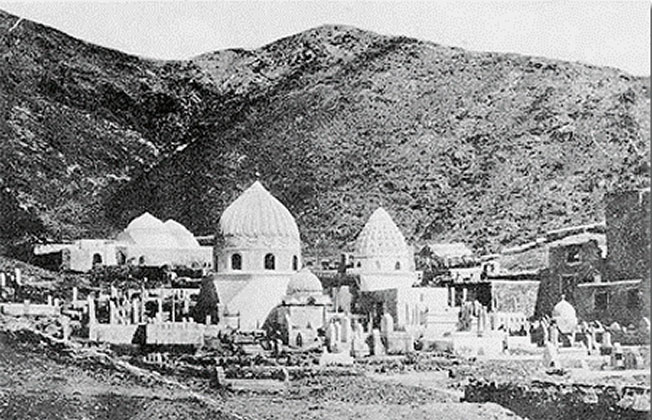 Bulldozed later by Saudi government, the mausoleum of Khadijah bint Khuwaylid the first wife of Muhammad. Older and much wealthier than him, Khadijah approached the young Muhammad for marriage years before the inception of Islam. She is the first Muslim in history—before Muhammad could believe himself.
the crave of the nymphs
Noah's dawn hard-on—he wakes up in sweat from a feverish body, an early morning wet-dream that instigates a project and mission that he registers as commissioned to him. His prophetic rise is felt as a form of faith as well as in his body.
The logic of dream appears to be the most convincing apparatus in the celestial narrative. The argument of the dream subjected to the logic of interpretation and association seams to have no problem in fully convincing the addressee of the gnostic call.
Pushkin's prophet which depicts the making of a prophet is a full body organ transplantation. The desert wanderer ambushed by an angle looses his body in a tormenting and torturous surgical operation and acquires a new poetic body.
Rilke's draw on the prophet's body emphasise the mouth. The prophet plays the medium for a volcanic divine performance in which his body explodes out the Logos of truth.
mouth
Faith is the main accomplishment of all the prophetic projects. Faith that traverses the collective bodies of Muslims. How the iconoclastic power of bodies flows with faith that makes the regime change of Islamic states savage?
Faith is a trajectory, produced by will.
the realm of metaphysics
space of action
the arbitrariness of the vector of faith happens on the gameboard of language
In early Islam the prophet is just a good man with God whom he has united in will but not in substance.
Some (speciality later converted) Muslims wanted the substance of God too. For them Muhammad's Islam was too practical and calculated. They wanted to feel their religion.
For the early mystics of Islam, merging with the substance of God was an experience superior to the prophet's who was charged with an external mission.
The mysticism deviated from Muhammad's original Islam was developed by those who wanted to "feel" their faith. There a great passivity rose in the few century after the beginning of Islam. However soon it developed enormous intellectual interests that took them to structured and directed contemplation. This new form of relation to the Absolute was away from the calculated pray. They practised to learn the associational logic of gnosis and learned to harvest the imaginative power of subconsciousness.
The early Sufism was given birth as an interest towards the channel that connected God to Muhammad. As a result they obsessed with the cave-period of Muhammad's life and not the rest of Islam as a project. They were interested in that which happened to Muhammad in the cave.
Zunun Misri (ذو النون المصري Dhul-Nun al-Misri) probably one of the very first sufis wanted the substance of Allah, the soul to be swallowed up by God and lost in him. Of course he saw this in stages and with guidance of a teacher.
We can divide the experience of faith into three categories or modalities: خوف، معرفت، عشق—fear, gnosis, love.
Fear (and dread) as a part of religious experience was emphasised by Muhammad.
Gnosis (or the mystic knowledge) was stressed by Zunun. For him the feeling of religion oriented around fundamental detachment.
Love as a modality of faith was organized mainly by Rumi. Unlike Zunun who was the first Sufi and the only tool available to him was detachment, Rumi had a teacher with great experience. His whole discourse of mysticism is based in his relationship with his Sheikh. He emphasised love in his practice because of Shams
Islam is foremost about one's relationship with God. In this sense it interacts, overlaps, and overwrites one's extensions of interpersonal relationships.
How dangerous it is the humanity devoted to one God.
Is it possible to gear off the quality of the one-to-one relationship from God to earthbound beings? Is the Darvish or the theist able to religiously turn worshipful love and commitment to other than Allah?
San'aan actually could redirect scandalously temporarily his faith towards another being, and rather a Majus a radical other from another religion.
شیخ صنعان (Sheikh San'aan) a mystic story from The Conference of the Birds - منطق الطیر - Manṭiq-uṭ-Ṭayr written by Attar - فرید الدین عطار, Persian Muslim poet and theoretician of Sufism.
مجوس (Majus) is someone from another religion that Islam even does not scan as legitimate belief, a radical taboo, Ḥarām حرام, or a killable other.
San'aan is the highest in his order, an acclaimed Imam or Sheikh at the top of the pyramid of worship. He has vision and gnosis and has access to channels of communication with the invisible (غيب).
When he dreams that he is worshipping an idol he knows immediately that this can not be his dream. He can not be having this dream. It has to be from another source. San'aan knows his psychic structure very well through the levels of meditations he renders on himself therefore is able to examine the deliveries of his subconsciousness. Nevertheless he sets for Italy. We can not be sure of how his navigational system is working or if his mystic GPS is failing him or not, or even what could be a trap here in the story. He goes to Rome and meets a Majus girl. She turns out to be a sexual sadist and they engage together in a series of sadomasochistic performances. That being the preconditions of San'aan's love for the Majus, the girl smartly asks of him to become the animal other. San'aan while being hold by latex-neck-band crawls in dirt as a pig.
...a sissy that I was with a prophetic character.
Quran, existing originally in the breasts of men, is part of a bigger universe of reading within the worlds of many Islams. In Quran one interprets the "few" in light of the "many", that means the overall analysis of the soul of all that which is said and done averages the exceptional utterances. Like any other "said" the word can mean anything. For that the scholar is dealing with Quran itself, Hadith (حديث - collections of quotes from Muhammad and other Imams), Tafsir (تفسير - exegesis or the "science" of interpretation), Kalām (كلام - Kalam or the overall more legitimate discourse in the history of Islam), Reports (نقل - or rummer that parasitically persists to be an illicit part of the body of discourse).
prophetic character
The prophet's body is not an ordinary one. In order to have a full CT-scan we might consider poetics, sadism, analysis, and narrative tropes to approach thinking and rethinking about this magical corporal figure of father.
My critique is on the prophetic character as a neurotic type in general.
monumentality of the figure of prophet
How the monotheist narrative conceals other forms of responses to the authority of God? Not everyone cringes when is summoned by the call.
Lunching missiles to the prophet's character, to that signifier that is hanging over my head, to his state and other masculinist idols, Father?
Material economy is hard-coded in the value of prayer and how it operates in the currency of believe in calculation of its own destiny. Goethe grasped this in his Faust, in the beginning when God and Devil gamble on the human soul.
cosmic individualism
The world’s first CO2-neutral city is taking shape in Abu Dhabi. Masdar City is to consume so little energy that local resources will satisfy requirements—without generating net emissions. The motivation behind this project is the fact that in 2004 Emirates was blamed for having the biggest ecological footprint.
Bulldozed later by Saudi government, the mausoleum of Khadijah bint Khuwaylid the first wife of Muhammad. Older and much wealthier than him, Khadijah approached the young Muhammad for marriage years before the inception of Islam. She is the first Muslim in history—before Muhammad could believe himself.
the crave of the nymphs
Noah's dawn hard-on—he wakes up in sweat from a feverish body, an early morning wet-dream that instigates a project and mission that he registers as commissioned to him. His prophetic rise is felt as a form of faith as well as in his body.
The logic of dream appears to be the most convincing apparatus in the celestial narrative. The argument of the dream subjected to the logic of interpretation and association seams to have no problem in fully convincing the addressee of the gnostic call.
Pushkin's prophet which depicts the making of a prophet is a full body organ transplantation. The desert wanderer ambushed by an angle looses his body in a tormenting and torturous surgical operation and acquires a new poetic body.
Rilke's draw on the prophet's body emphasise the mouth. The prophet plays the medium for a volcanic divine performance in which his body explodes out the Logos of truth.
mouth
Faith is the main accomplishment of all the prophetic projects. Faith that traverses the collective bodies of Muslims. How the iconoclastic power of bodies flows with faith that makes the regime change of Islamic states savage?
Faith is a trajectory, produced by will.
the realm of metaphysics
space of action
the arbitrariness of the vector of faith happens on the gameboard of language
In early Islam the prophet is just a good man with God whom he has united in will but not in substance.
Some (speciality later converted) Muslims wanted the substance of God too. For them Muhammad's Islam was too practical and calculated. They wanted to feel their religion.
For the early mystics of Islam, merging with the substance of God was an experience superior to the prophet's who was charged with an external mission.
The mysticism deviated from Muhammad's original Islam was developed by those who wanted to "feel" their faith. There a great passivity rose in the few century after the beginning of Islam. However soon it developed enormous intellectual interests that took them to structured and directed contemplation. This new form of relation to the Absolute was away from the calculated pray. They practised to learn the associational logic of gnosis and learned to harvest the imaginative power of subconsciousness.
The early Sufism was given birth as an interest towards the channel that connected God to Muhammad. As a result they obsessed with the cave-period of Muhammad's life and not the rest of Islam as a project. They were interested in that which happened to Muhammad in the cave.
Zunun Misri (ذو النون المصري Dhul-Nun al-Misri) probably one of the very first sufis wanted the substance of Allah, the soul to be swallowed up by God and lost in him. Of course he saw this in stages and with guidance of a teacher.
We can divide the experience of faith into three categories or modalities: خوف، معرفت، عشق—fear, gnosis, love.
Fear (and dread) as a part of religious experience was emphasised by Muhammad.
Gnosis (or the mystic knowledge) was stressed by Zunun. For him the feeling of religion oriented around fundamental detachment.
Love as a modality of faith was organized mainly by Rumi. Unlike Zunun who was the first Sufi and the only tool available to him was detachment, Rumi had a teacher with great experience. His whole discourse of mysticism is based in his relationship with his Sheikh. He emphasised love in his practice because of Shams
Islam is foremost about one's relationship with God. In this sense it interacts, overlaps, and overwrites one's extensions of interpersonal relationships.
How dangerous it is the humanity devoted to one God.
Is it possible to gear off the quality of the one-to-one relationship from God to earthbound beings? Is the Darvish or the theist able to religiously turn worshipful love and commitment to other than Allah?
San'aan actually could redirect scandalously temporarily his faith towards another being, and rather a Majus a radical other from another religion.
شیخ صنعان (Sheikh San'aan) a mystic story from The Conference of the Birds - منطق الطیر - Manṭiq-uṭ-Ṭayr written by Attar - فرید الدین عطار, Persian Muslim poet and theoretician of Sufism.
مجوس (Majus) is someone from another religion that Islam even does not scan as legitimate belief, a radical taboo, Ḥarām حرام, or a killable other.
San'aan is the highest in his order, an acclaimed Imam or Sheikh at the top of the pyramid of worship. He has vision and gnosis and has access to channels of communication with the invisible (غيب).
When he dreams that he is worshipping an idol he knows immediately that this can not be his dream. He can not be having this dream. It has to be from another source. San'aan knows his psychic structure very well through the levels of meditations he renders on himself therefore is able to examine the deliveries of his subconsciousness. Nevertheless he sets for Italy. We can not be sure of how his navigational system is working or if his mystic GPS is failing him or not, or even what could be a trap here in the story. He goes to Rome and meets a Majus girl. She turns out to be a sexual sadist and they engage together in a series of sadomasochistic performances. That being the preconditions of San'aan's love for the Majus, the girl smartly asks of him to become the animal other. San'aan while being hold by latex-neck-band crawls in dirt as a pig.
...a sissy that I was with a prophetic character.
Quran, existing originally in the breasts of men, is part of a bigger universe of reading within the worlds of many Islams. In Quran one interprets the "few" in light of the "many", that means the overall analysis of the soul of all that which is said and done averages the exceptional utterances. Like any other "said" the word can mean anything. For that the scholar is dealing with Quran itself, Hadith (حديث - collections of quotes from Muhammad and other Imams), Tafsir (تفسير - exegesis or the "science" of interpretation), Kalām (كلام - Kalam or the overall more legitimate discourse in the history of Islam), Reports (نقل - or rummer that parasitically persists to be an illicit part of the body of discourse).
prophetic character
The prophet's body is not an ordinary one. In order to have a full CT-scan we might consider poetics, sadism, analysis, and narrative tropes to approach thinking and rethinking about this magical corporal figure of father.
My critique is on the prophetic character as a neurotic type in general.
monumentality of the figure of prophet
How the monotheist narrative conceals other forms of responses to the authority of God? Not everyone cringes when is summoned by the call.
Lunching missiles to the prophet's character, to that signifier that is hanging over my head, to his state and other masculinist idols, Father?
Material economy is hard-coded in the value of prayer and how it operates in the currency of believe in calculation of its own destiny. Goethe grasped this in his Faust, in the beginning when God and Devil gamble on the human soul.
cosmic individualism
The world’s first CO2-neutral city is taking shape in Abu Dhabi. Masdar City is to consume so little energy that local resources will satisfy requirements—without generating net emissions. The motivation behind this project is the fact that in 2004 Emirates was blamed for having the biggest ecological footprint.
 A look inside the Masdar City; a 3D-render of a public space in Masdar City, an imagined reality. Its core being a 'planned city' (designed by the British architectural firm Foster and Partners), the city relies on solar energy and other renewable energy sources. Its first tenant, the Masdar Institute of Science and Technology is a research-oriented university, where students of opposite sex virtually attend seminars, separated and mediated via a live video feed.
A look inside the Masdar City; a 3D-render of a public space in Masdar City, an imagined reality. Its core being a 'planned city' (designed by the British architectural firm Foster and Partners), the city relies on solar energy and other renewable energy sources. Its first tenant, the Masdar Institute of Science and Technology is a research-oriented university, where students of opposite sex virtually attend seminars, separated and mediated via a live video feed.(Image from siemens.com) “Indeed, We (God) offered the Trust to the heavens and the earth and the mountains, and they declined to bear it and feared it; but man [undertook to] bear it. Indeed, he was unjust and ignorant.” (Qur’an 33:72)
 “...And do not commit abuse on the earth, spreading corruption.” Qur’an, 2:60
“...And do not commit abuse on the earth, spreading corruption.” Qur’an, 2:60